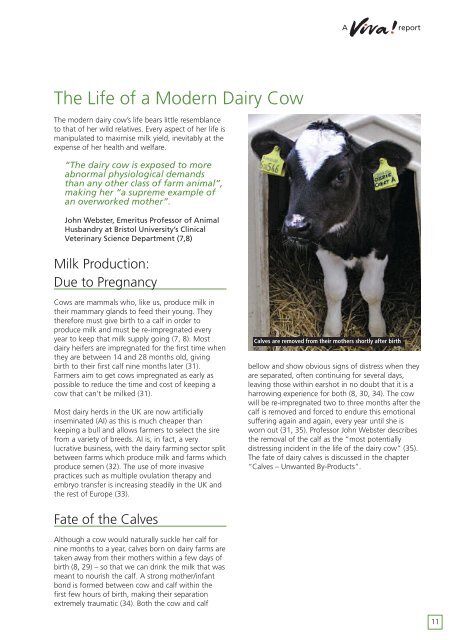Create successful ePaper yourself
Turn your PDF publications into a flip-book with our unique Google optimized e-Paper software.
A<strong>report</strong>The Life <strong>of</strong> a Modern <strong>Dairy</strong> CowThe modern dairy cow’s life bears little resemblanceto that <strong>of</strong> her wild relatives. Every aspect <strong>of</strong> her life ismanipulated to maximise milk yield, inevitably at theexpense <strong>of</strong> her health and welfare.“The dairy cow is exposed to moreabnormal physiological demandsthan any other class <strong>of</strong> farm animal”,making her “a supreme example <strong>of</strong>an overworked mother”.John Webster, Emeritus Pr<strong>of</strong>essor <strong>of</strong> AnimalHusbandry at Bristol University’s ClinicalVeterinary Science Department (7,8)Milk Production:Due to PregnancyCows are mammals who, like us, produce milk intheir mammary glands to feed their young. Theytherefore must give birth to a calf in order toproduce milk and must be re-impregnated everyyear to keep that milk supply going (7, 8). Mostdairy heifers are impregnated for the first time whenthey are between 14 and 28 months old, givingbirth to their first calf nine months later (31).Farmers aim to get cows impregnated as early aspossible to reduce the time and cost <strong>of</strong> keeping acow that can’t be milked (31).Most dairy herds in the UK are now artificiallyinseminated (AI) as this is much cheaper thankeeping a bull and allows farmers to select the sirefrom a variety <strong>of</strong> breeds. AI is, in fact, a verylucrative business, with the dairy farming sector splitbetween farms which produce milk and farms whichproduce semen (32). The use <strong>of</strong> more invasivepractices such as multiple ovulation therapy andembryo transfer is increasing steadily in the UK andthe rest <strong>of</strong> Europe (33).Calves are removed from their mothers shortly after birthbellow and show obvious signs <strong>of</strong> distress when theyare separated, <strong>of</strong>ten continuing for several days,leaving those within earshot in no doubt that it is aharrowing experience for both (8, 30, 34). The cowwill be re-impregnated two to three months after thecalf is removed and forced to endure this emotionalsuffering again and again, every year until she isworn out (31, 35). Pr<strong>of</strong>essor John Webster describesthe removal <strong>of</strong> the calf as the “most potentiallydistressing incident in the life <strong>of</strong> the dairy cow” (35).The fate <strong>of</strong> dairy calves is discussed in the chapter“Calves – Unwanted By-Products”.Fate <strong>of</strong> the CalvesAlthough a cow would naturally suckle her calf fornine months to a year, calves born on dairy farms aretaken away from their mothers within a few days <strong>of</strong>birth (8, 29) – so that we can drink the milk that wasmeant to nourish the calf. A strong mother/infantbond is formed between cow and calf within thefirst few hours <strong>of</strong> birth, making their separationextremely traumatic (34). Both the cow and calf11


